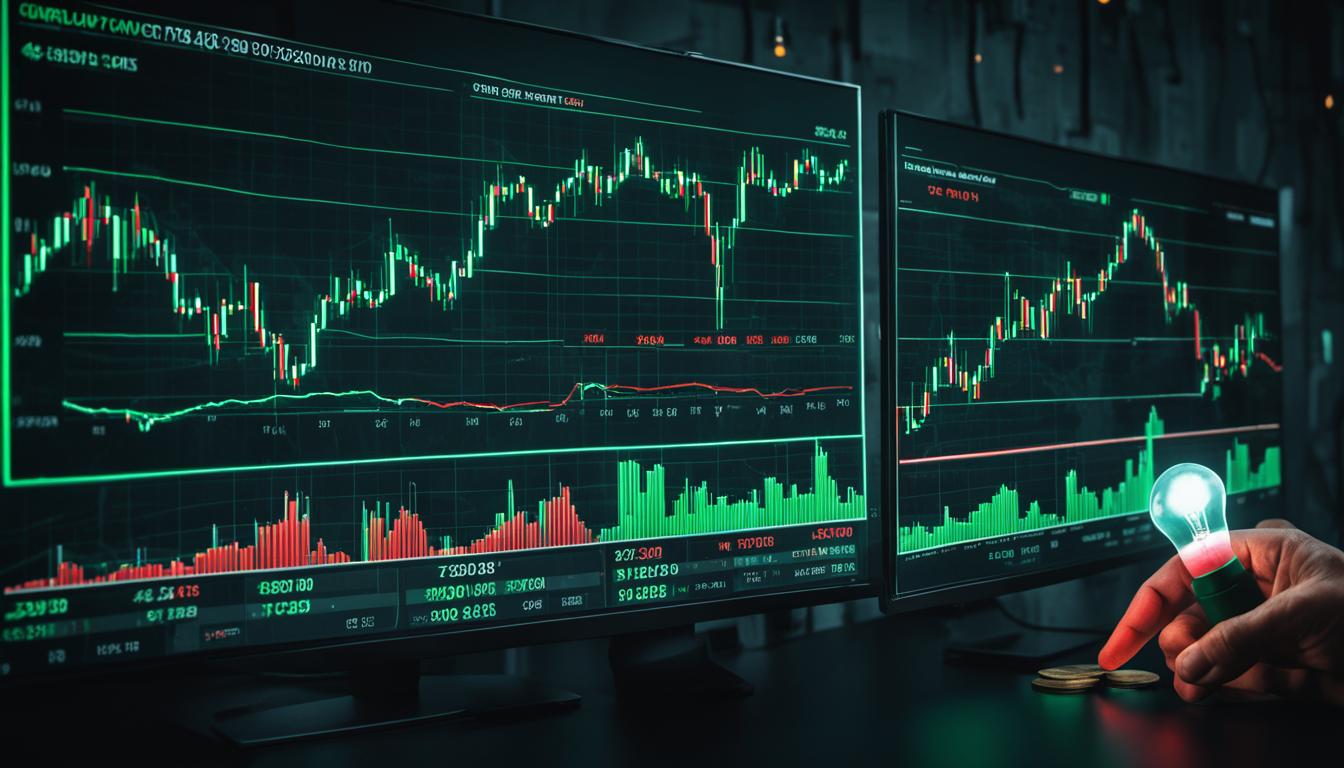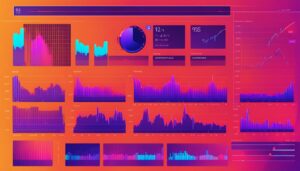When it comes to forex trading, understanding when to buy or sell a currency pair is crucial for success. With so many factors influencing the market, it can be challenging to navigate without a solid strategy. In this article, I will guide you through the essential elements of formulating effective currency trading strategies and provide valuable tips on analyzing market trends and using technical indicators.
Key Takeaways:
- Developing a forex trading strategy based on technical or fundamental analysis is essential for making informed buy or sell decisions.
- Utilize trading signals from reliable forex signals providers to trigger your trades.
- Backtest and paper-trade your strategies before executing them with real money.
- Understand the components of a trading strategy, including market selection, position sizing, entry and exit points, and trading tactics.
- Consider your risk preferences and leverage options offered by your broker.
The Best Time Frames for Forex Trading
When it comes to forex trading, determining the best time frame to trade is crucial for success. The choice of time frame depends on factors such as your trading strategy, objectives, and trading style. Let’s explore the different time frames and their suitability for various trading strategies.
Short-Term Time Frames
Short-term time frames, ranging from a few minutes to a few hours or days, are perfect for traders who want to take advantage of highly volatile market conditions. These time frames are favored by day traders and scalpers who aim to profit from quick price movements within a short period. They closely monitor technical indicators and use short-term trading strategies to capitalize on short-lived market opportunities.
Medium-Term Time Frames
If you’re looking to capitalize on anticipated future market trends, medium-term time frames ranging from a few weeks to several months might be the right choice. Traders following swing trading or momentum trading strategies often analyze price patterns and technical indicators on these time frames. They aim to ride the trend for a significant duration and exit their positions before any major trend reversal.
Long-Term Time Frames
For traders who prefer a buy and hold strategy, long-term time frames spanning a few months to several years provide a broader perspective of the market. Long-term traders analyze fundamental factors, economic indicators, and geopolitical events to make informed decisions. They look for sustainable trends and aim to capture larger price movements over an extended period.
It’s important to note that different traders have varying time frame preferences based on their trading styles and objectives. Day traders, position traders, momentum traders, scalpers, swing traders, and algorithmic traders all have their unique time frame preferences.
Combining Time Frames
Traders can also combine multiple time frames to strengthen their analysis. By examining the market trend on different time frames, they gain a more comprehensive understanding of the price action. For example, a trader may use the daily chart to identify the long-term trend, the hourly chart to refine entry and exit points, and the 15-minute chart to time their trades more precisely.
In conclusion, the best time frame for forex trading depends on your trading strategy, objectives, and trading style. Whether you prefer short-term, medium-term, or long-term trading, it’s essential to choose a time frame that aligns with your goals and provides you with the necessary analytical insights. Remember, each time frame offers unique opportunities and challenges, so it’s crucial to stay disciplined and adapt your approach accordingly.
Understanding Forex Trading Strategies
Forex trading strategies are essential tools for traders to navigate the highly volatile and fast-paced world of foreign exchange. Whether you are a beginner or an experienced trader, understanding different forex trading strategies is crucial for success. In this section, we will explore some popular strategies used by traders to make informed buy or sell decisions in the currency market.
Fundamental Analysis
Fundamental analysis is a strategy that focuses on analyzing economic, social, and political factors that influence currency values. Traders using this approach study economic indicators, such as GDP, employment rates, and inflation, to assess the strength of a country’s economy. Social and political events, like elections or government policies, can also impact currency prices. By keeping an eye on these factors, traders aim to predict currency movements and identify potential buying or selling opportunities.
Technical Analysis
Technical analysis relies on studying historical price and volume data to predict future market movements. Traders using this strategy analyze charts, patterns, and technical indicators to identify trends and patterns. They believe that historical price movements repeat themselves and use these patterns to make informed trading decisions. Technical analysis can help traders determine entry and exit points, as well as predict support and resistance levels.
Carry Trade
Carry trade is a popular strategy used by traders to take advantage of interest rate differentials between currencies. Traders borrow money in a low-interest-rate currency and invest it in a high-interest-rate currency. By doing so, they aim to earn the interest rate difference as profit. However, carry trade strategies are not without risks, as changes in interest rates or market conditions can impact currency values.
Breakout Strategy
Breakout strategy is based on the concept of identifying key levels of support and resistance in the market. Traders using this strategy enter trades when the price breaks out of these levels. The breakout can indicate a potential change in market sentiment, and traders aim to capitalize on these movements. This strategy requires careful analysis and the ability to identify significant price levels accurately.
Scalping
Scalping is a short-term trading strategy that aims to capture small price movements multiple times a day. Scalpers take advantage of intraday volatility and focus on quick trades with small profit targets. This strategy requires traders to be highly disciplined, as they need to enter and exit trades swiftly. Scalping can be intense and requires constant monitoring of the market.
Momentum Traders
Momentum traders focus on buying or selling currency pairs based on their trend’s direction. They believe that prices that have been moving in a particular direction will continue to do so. Traders using this strategy aim to ride the momentum and make profits as long as the trend persists. This strategy requires traders to be skilled at identifying and confirming trends.
Algorithmic Traders
Algorithmic traders place trading orders based on computer programs at the best possible time and exchange rate. These programs are designed to execute trades automatically based on predefined criteria or algorithms. Algorithmic trading allows traders to take advantage of market opportunities without human emotions or biases. However, it requires technical expertise in programming and backtesting strategies.
Traders should educate themselves about each strategy, practice using demo accounts, and evaluate performance to determine which strategy suits them best. It is important to remember that there is no one-size-fits-all approach in forex trading. Each strategy has its advantages and disadvantages, and traders should adapt and refine their strategies over time to align with their goals and risk tolerance.
Next, we will dive into the major currency pairs and their characteristics, helping you focus on the most traded pairs in the forex market.
The Major Currency Pairs and Their Characteristics
When it comes to forex trading, understanding the major currency pairs and their characteristics is essential. These pairs are the most heavily traded in the forex market and provide ample opportunities for traders. Let’s take a closer look at the major currency pairs, as well as other types of currency pairs you may encounter.
Major Currency Pairs
The major currency pairs consist of the most dominant currencies in the world. They include pairs like EUR/USD, USD/JPY, and GBP/USD. These pairs offer high liquidity and tend to have tight spreads, making them attractive to traders. The movements of major currency pairs are often influenced by key economic and political events, making them popular for those who rely on fundamental analysis.
Minor Currency Pairs
In contrast to major currency pairs, minor currency pairs do not include the US dollar. Examples of minor currency pairs include EUR/GBP and AUD/JPY. While they may have lower liquidity and wider spreads compared to major pairs, they can present trading opportunities for those who specialize in specific currencies or regions.
Exotic Currency Pairs
Exotic currency pairs involve a major currency paired with a currency from an emerging or less commonly traded economy. Examples include USD/BRL and EUR/TRY. These pairs tend to have higher spreads and lower liquidity compared to major and minor pairs. Traders who are comfortable with higher risk may find opportunities in trading exotic currency pairs.
Base Currency and Quote Currency
In a currency pair, one currency is the base currency, while the other is the quote currency. The base currency represents the unit of account or the currency being bought, while the quote currency represents the currency being sold or exchanged. For example, in the EUR/USD pair, the euro is the base currency and the US dollar is the quote currency.
When choosing a currency pair to trade, there are several factors to consider. Liquidity is important as it ensures ease of buying and selling. Volatility indicates the potential for price movements and profit opportunities. Spreads represent the difference between the bid and ask prices, affecting transaction costs. Correlations between currency pairs can provide insights into market trends and diversification.
Understanding the major currency pairs and their characteristics is vital for any forex trader. By analyzing the behavior of these pairs and considering their specific traits, traders can make informed decisions and increase their chances of success in the dynamic forex market.
| Pair | Description |
|---|---|
| EUR/USD | Euro against US Dollar |
| USD/JPY | US Dollar against Japanese Yen |
| GBP/USD | British Pound against US Dollar |
| EUR/GBP | Euro against British Pound |
| AUD/JPY | Australian Dollar against Japanese Yen |
| USD/BRL | US Dollar against Brazilian Real |
| EUR/TRY | Euro against Turkish Lira |
Developing a Solid Forex Trading Plan
Developing a solid forex trading plan is a crucial step towards achieving success in the dynamic and volatile forex market. By having a well-defined plan, traders can effectively navigate the complexities of currency trading and maximize their potential profits.
When creating a forex trading plan, it is essential to start by defining your goals, risk tolerance, and trading style. Knowing what you want to achieve and the level of risk you are comfortable with will help you make informed decisions and stay focused on your objectives.
Risk management is another critical aspect of a solid trading plan. Protecting your capital should be a top priority, and this can be achieved by implementing proper risk management techniques. Determine the position size that aligns with your risk tolerance and establish clear guidelines on the maximum amount of money you are willing to risk in each trade.
Setting specific rules for entry and exit points is also essential for maintaining discipline and consistency in your trading. Define the strategies you will use to identify the right time to buy or sell currency pairs and establish guidelines for managing open positions. This will help you avoid impulsive decisions based on emotions and stick to your predetermined plan.
It is crucial to use reliable forex trading platforms that provide accurate and up-to-date market data. Choose a platform that offers robust execution technologies, ensuring that your trades are executed efficiently and at the best possible prices. This will help you capitalize on trading opportunities and enhance your overall trading performance.

Example Forex Trading Plan Template:
| Components | Description |
|---|---|
| Goals | Define your short-term and long-term goals for trading forex. |
| Risk Tolerance | Determine the level of risk you are willing to take in your trades. |
| Trading Style | Identify your preferred trading style, such as day trading, swing trading, or position trading. |
| Risk Management | Establish guidelines for position sizing and risk control. |
| Entry and Exit Rules | Define specific criteria for entering and exiting trades based on your chosen trading strategies. |
| Trading Tactics | Develop a set of rules for managing open positions, including stop-loss and take-profit levels. |
Remember, a forex trading plan is not set in stone and should be reviewed and updated regularly to adapt to changing market conditions and personal circumstances. By following a well-crafted plan, you can stay focused, disciplined, and increase your chances of success in the forex market.
Common Forex Trading Strategies for Currency Pairs
When it comes to trading currency pairs, there are several common forex trading strategies that traders employ to make informed decisions. These strategies utilize different approaches, tools, and indicators to analyze the market and identify potential opportunities. Let’s take a closer look at some of the most widely used strategies:
Fundamental Analysis
Fundamental analysis is a strategy that focuses on economic factors, news events, and geopolitical events to predict currency movements. Traders who use fundamental analysis analyze economic indicators, such as GDP, interest rates, employment data, and inflation rates, as well as news events and political developments that can impact currency values. By understanding the underlying fundamentals of the market, traders can make informed decisions about when to buy or sell currency pairs.
Technical Analysis
Technical analysis involves studying historical price and volume data, patterns, and indicators to identify trends and predict future market movements. Traders who use technical analysis utilize various chart patterns, such as support and resistance levels, trendlines, and moving averages, to identify potential entry and exit points. Popular technical indicators, such as the Relative Strength Index (RSI), Moving Average Convergence Divergence (MACD), and Bollinger Bands, can also help traders gauge the strength of a trend and determine when to enter or exit a trade.
Breakout Strategy
The breakout strategy aims to identify key levels of support and resistance and enter trades when the price breaks out of these levels. Traders who use this strategy look for consolidation patterns, such as triangles, rectangles, and wedges, which indicate that the price is likely to break out in one direction. By entering trades when the price breaks above a resistance level or below a support level, traders can capture potential profits as the price continues to move in the breakout direction.
Carry Trade
The carry trade strategy aims to profit from the interest rate differential between two currencies. Traders who use this strategy borrow in a low-interest-rate currency and invest in a high-interest-rate currency to earn the interest rate spread. This strategy is based on the assumption that currencies with higher interest rates will appreciate relative to those with lower interest rates. However, it is important to consider the potential risks, such as changes in interest rates and currency exchange rates, when implementing the carry trade strategy.
Scalping
Scalping is a short-term trading strategy that involves capturing small price movements multiple times a day. Traders who use this strategy aim to take advantage of short-term volatility and liquidity in the market. Scalpers typically employ technical analysis techniques, such as identifying short-term trends and using small time frames, to enter and exit trades quickly. This strategy requires discipline, quick decision-making, and the ability to manage multiple trades simultaneously.
Momentum Trading
Momentum trading focuses on buying and selling currency pairs according to their trend’s direction. Traders who use this strategy aim to capture profits by riding the momentum of a strong market trend. This strategy relies on technical indicators, such as moving averages and trendlines, to identify trends and determine when to enter and exit trades. It is important for momentum traders to closely monitor market conditions and be prepared to exit trades if the momentum begins to weaken.
Algorithmic Trading
Algorithmic trading involves placing trading orders based on computer programs that automatically execute trades at the best possible time and exchange rate. Traders who use this strategy rely on complex algorithms and mathematical models to analyze market data, identify trading opportunities, and execute trades without human intervention. Algorithmic trading allows for precise and rapid execution, as well as the ability to backtest and optimize trading strategies based on historical data.
Each of these forex trading strategies offers its own advantages and considerations. Traders should carefully assess their trading goals, risk tolerance, and market conditions to determine which strategy aligns best with their needs. It is also important to continuously educate oneself, practice using demo accounts, and evaluate performance when implementing any trading strategy.
| Strategy | Description |
|---|---|
| Fundamental Analysis | Focus on economic factors, news events, and geopolitical events to predict currency movements. |
| Technical Analysis | Study historical price and volume data, patterns, and indicators to identify trends and predict future market movements. |
| Breakout Strategy | Identify key levels of support and resistance and enter trades when the price breaks out of these levels. |
| Carry Trade | Profit from the interest rate differential between two currencies by borrowing in a low-interest-rate currency and investing in a high-interest-rate currency. |
| Scalping | Capture small price movements multiple times a day by taking advantage of short-term volatility and liquidity in the market. |
| Momentum Trading | Buy and sell currency pairs according to their trend’s direction to capture profits from strong market trends. |
| Algorithmic Trading | Place trading orders based on computer programs that automatically execute trades at the best possible time and exchange rate. |
Conclusion
To master forex trading and know when to buy or sell a currency pair, you need to develop effective forex trading strategies. These strategies can be based on fundamental analysis, technical analysis, breakout strategy, carry trade, scalping, momentum trading, or algorithmic trading. It’s important to choose the right currency pairs to trade based on liquidity, volatility, spreads, and correlations. By developing a solid forex trading plan, managing risk effectively, and using reliable forex trading platforms, you can increase your chances of success.
Understanding market trends, analyzing indicators, and implementing the right strategies are crucial aspects of forex trading. Constantly monitoring currency market trends, conducting forex market analysis, and staying informed about economic news can help you make informed trading decisions. Whether you’re a beginner or an experienced trader, continuous learning and adapting your strategies to changing market conditions are key to maximizing your profits.
Remember, forex trading involves risks, and it’s important to be disciplined, patient, and realistic with your expectations. Stay focused, remain consistent with your trading plan, and don’t let emotions cloud your judgment. By incorporating the right forex trading strategies, keeping up with currency trading tips, and staying updated on market trends, you can navigate the dynamic world of forex trading with confidence.
FAQ
What is a forex trading strategy?
A forex trading strategy is a technique used to determine whether to buy or sell a currency pair at a certain time. It can be based on technical analysis or fundamental, news-based events. Traders develop strategies based on trading signals that trigger buy or sell decisions.
How do traders generate trading signals for their strategies?
Traders use manual and automated tools to generate trading signals. These tools analyze market data and provide indications of when to enter or exit a trade.
Why is it important to backtest and paper-trade a forex trading strategy?
Backtesting involves running a strategy on historical data to evaluate its performance. Paper-trading, or trading with virtual money, allows traders to test their strategy in real-time market conditions without risking actual capital.
What are the components of a forex trading strategy?
A forex trading strategy requires components such as selecting the market, position sizing, entry and exit points, and trading tactics. Each component plays a crucial role in determining the success of the strategy.
How does leverage affect forex trading strategies?
The leverage offered by a broker can impact the capital and risk preferences of a trader. Traders should consider their risk tolerance and choose an appropriate leverage level that aligns with their trading strategy.
When should traders change their forex trading strategies?
Traders should consider changing their strategies when their risk management is not suitable, market conditions evolve, or they lack comprehension of the strategy. Adapting strategies to changing circumstances is crucial for long-term success.
What are the different types of forex trading strategies?
Forex trading strategies can include fundamental analysis, technical analysis, breakout strategy, carry trade, scalping, momentum trading, and algorithmic trading. Each strategy focuses on different factors and techniques to generate trading decisions.
How do traders choose the right currency pair to trade?
Traders consider factors such as liquidity, volatility, spreads, and correlations when choosing a currency pair to trade. These factors help determine the potential risks and rewards associated with a particular pair.
How important is risk management in forex trading?
Risk management is crucial in forex trading to protect capital. Traders should define their risk tolerance, set rules for position sizing, and control the amount of risk in each trade. A solid risk management strategy helps ensure long-term profitability.
What are some common forex trading strategies for currency pairs?
Common forex trading strategies include fundamental analysis, technical analysis, breakout strategy, carry trade, scalping, momentum trading, and algorithmic trading. Each strategy employs different techniques to identify potential trading opportunities.
How can traders maximize their chances of success in forex trading?
Traders can maximize their chances of success in forex trading by mastering different strategies, understanding market trends, analyzing indicators, practicing on demo accounts, evaluating performance, and using reliable forex trading platforms.





